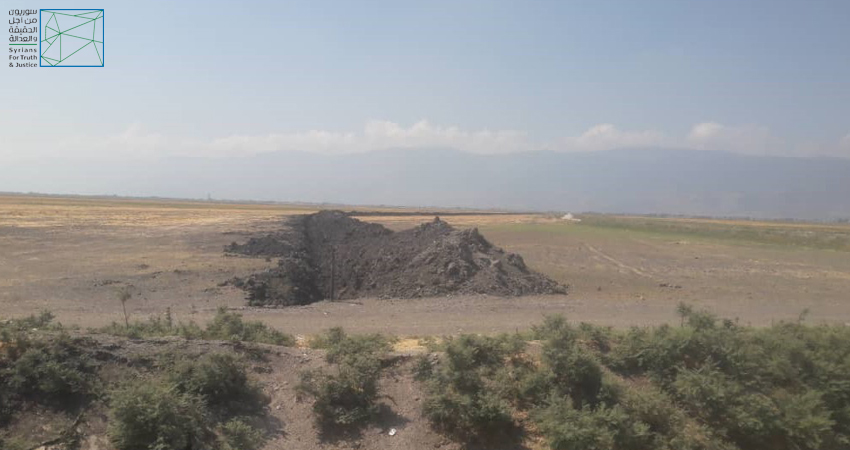Introduction:
The period from March 2019 to September 19 of the same year witnessed the Turkistan Islamic Party/TIP’s continued acts of confiscation and pillage which targeted public properties in western rural Hama.
Having plundered the Zayzoun Power Station, al-Ziyara District,[1] in April 2019, TIP-affiliated personnel embarked on an extensive process of excavation, seeking to dig out the gas pipelines that feed the station, which they sold to local merchants, ignoring the importance of this network of pipelines which operates several power stations throughout Syria, including al-Taim Power Station in Deir ez-Zor Province, al-Suwaidiya in al-Hasaka and eastern Aleppo and Jandar in Homs Province, as well as the power stations of Mahrde, Zayzoun and al-Zara in Hama Province, given that the digging activities continued to the date this report was published—namely, September 19, 2019.
The Syrian regular forces, according to information obtained by Syrians for Truth and Justice/STJ, have bombarded towns in western rural Hama—Qastoun, Hmaimat and Shaghureet—after monitoring the digging and confiscation of gas pipelines by the personnel of the TIP, which resulted in the injury of a number of civilians and inflicted destruction upon several of their homes, as artillery shelling continued to target these areas from May to August 2019.
One expert pointed out that the TIP’s removal of the pipelines, feeding the Zayzoun Power Station with methane gas, has negative impact on environment, for uneven amounts of methane are being released into air, threatening to inflate the concentration of greenhouse gases, not to mention that exposure to huge quantities of methane might cause suffocation and death eventually.
In March 2019, within the frame of its looting and pillage activities, the TIP had explicitly auctioned possessions belonging to the al-Assi Basin Company, the al-Ziyarah District’s Division, which tackled the regulation and pumping of irrigation water from the Assi/Orontes River to the Qastoun and Zayzoun dams, for, in 2016, TIP- affiliated fighters have seized and pillaged the division’s contents, including pumping equipment, irrigation pipelines, and agricultural and service machines and vehicles, turning the company’s headquarters into a military post.
In former years, the TIP, along with Hayat Tahrir al-Sham/HTS, had participated in the confiscation of several public properties including the equipment of the National Hospital and took over the headquarters of the Sundus Consumer Foundation that are both located in the city of Jisr al-Shughur, in addition to dismantling and robbing the railway linking rural Latakia with Jisr al-Shughour region in 2015.[2]
1. The Turkistan Islamic Party:
Most of the references written about the Turkistan Islamic Party/TIP/Uighurs track the beginnings of the Party in Syria to 2012, for its fighters have initially grouped in Turkey and then entered Syria crossing the border strip between the two countries.[3]
The TIP’s fighters amassed mainly in the strategic city of Jisr al-Shughour, the city of Idlib, al-Summak Mountain, al-Ghab Plain, and the Kurd and the Turkmen mountains, known as Latakia Mountains which are located in the province’s rural parts alongside the Turkish-Syrian border.[4] Being deployed near the Turkish-Syrian border strip indicates that they have obtained logistic aid from Turkey, at least when it comes to recruits that the Party is in need for.[5]
A media activist, based in Jisr al-Shughur, reported to STJ that in March 2019, a Turkish media delegation visited the Syrian Jisr al-Shughur and called on one of the TIP’s strongholds in the area, which was accustomed to turning down the media. The case, however, was different with the Turkish media team that was welcomed by the TIP’s personnel and managed to record statements made by a number of its leaders, which functions to highlight the close relationship between Turkey and the TIP, as he put it.
Once in control of Jisr al-Shughur City, rural Idlib, on April 25, 2015, Jabhat al-Nusra/ al-Nusra Front/ Qaeda and the TIP, as well as Harakat Ahrar al-Sham al-Islamiya/Ahrar al-Sham devised to split the city into two enclaves. Back then, HTS and the TIP held the reins to power in the northern and western enclave of the city— the one covering the largest geographical area northwest of al-Assi River. Ahrar al-Sham and Ansar Al-Sham Brigades, for their part, held control over the city’s eastern enclave, located in the eastern side of al-Assi River that divides the city into two banks.[6] It seems that the al-Nusra Front has backed the TIP, offering guidance as it arrived into Idlib and helping it settle down in Christian and Alawite majority towns abandoned by their residents.[7]
In 2015, alongside Jund al-Aqsa/Soldiers of al-Aqsa, the TIP took part in battles against the Syrian regular forces, stationed in the towns of al-Ziyara and Khirbet al-Naqus, rural Hama. In August 2015, relying on suicide attacks, the TIP managed to take over the towns of al-Ziyara, al-Qarqur, al-Mashik and Khirbet al-Naqus, western rural Hama, which from then on were run by it, on the levels of economy and military.
In June 2016, the TIP made open its opinion on the caliphate, declared by the Islamic State/ISIS, deeming it legitimate and calling at the same time for establishing an “Islamic Caliphate in accordance with proper legal and political conditions”. The statement was back then made by the Party’s leading figure/Prince,[8] Abdulhaq Turkistani— whom the US State Department has classified as a terrorist in 2009.[9]
The TIP is considered an exceptional phenomenon, when it comes to the military scene in Syria, for the Party’s fighters have brought their families along to “the land of Jihad” and have managed over time to adapt to the new environment, not to mention that their own tactics have enabled them to dodge too many a conflict, which led the Party up to the present time. Today, the TIP is a major force in the Syrian military playground especially that ISIS has been brought to an end. These factors make it more than legitimate to raise many questions about the party’s futuristic role and fate.[10]
In Syria, the TIP consists is of two division. The major one is headed by Abu Muhammad Turkistani, which fighters are mainly from eastern China while encompassing the largest number of recruits —about 3000 fighters— mobilized in mountainous terrains and river areas. These fighters have established training centers and housing compounds for their families in Jisr al-Shughur, in an area formerly inhabited by Christians. The mountainous areas, the Kurd and the Turkman mountains, are preserved for militants, who actually wish to retreat into such areas.
The Syrian/minor division, dubbed S-TIP, incorporates fighters affiliated with al-Aqsa Brigade in Hama, who announced joining the Party on February 23, 2017, knowing that al-Aqsa Brigade had operated under ISIS. The minor division’s count of recruits’ amounts to 450 fighters, who adopted a new name— the Medical battalion, which sometimes goes by the name the Logistic Battalion—while they generally hold the title of al-Ansar/Advocates, which they are known for within the domestic sphere of the Party. Mostly from the city of Hama, and led by Mohammad Zauawar,[11] the Party’s fighters are currently taking positions in a number of regions, including:
- The main residential area in the city of Jisr al-Shughour, which is the central area for the residence of TIP fighters and leaders responsible for all aspects of organizational duties.
- The area extending from the Mumhambel Bridge, east of Jisr al-Shughur, to the Zayzoun and Kargur power stations, as far as the eastern end of al-Assi River in al-Ghab Plain. This region is an incubator for a number of military strongholds, the locations of which were decided under a cooperation between the TIP and HTS, given that the latter also has military posts in the area.
- Posts designated for military purposes that are located in the Turkmen and the Kurd mountains, where the Party cooperates with HTS, forces affiliated with the National Liberation Front/NFL and Iraqi Islamic armed groups.
- A few organizational and military posts of the TIP are located in the city of Sarmin and the town of Neirab, near the city of Idlib, in addition to eastern rural Hama— outside the demilitarized zone— where the Party cooperates with moderate military armed groups, such as the Central Division, Tajamu al-Izza/Izza Group, and Force 23.[12]
Conspiracy
The TIP has joint camps with Uzbek and Caucasian battalions in mountainous areas, where their children, over the age of twelve, are trained to bear arms and on fighting skills. Uyghur women also participate in special camps where they are trained to take up arms.[13]
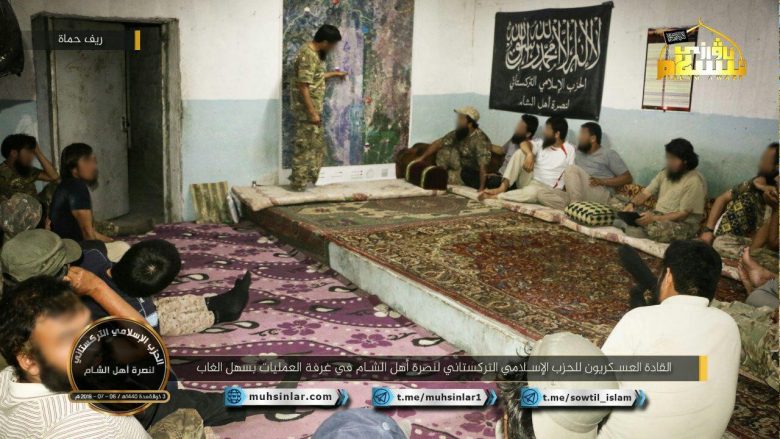
Leaders of the TIP in al-Ghab Plain Operations Room, rural Hama. Taken on: July 12, 2019. Photo credit: The reporter of the “Turkistan Islamic Party- Official Channel.
On July 16, 2019, the Reporter of TIP – Official Channel published a photo of what it captioned as military operations against the posts of the Syrian Government.
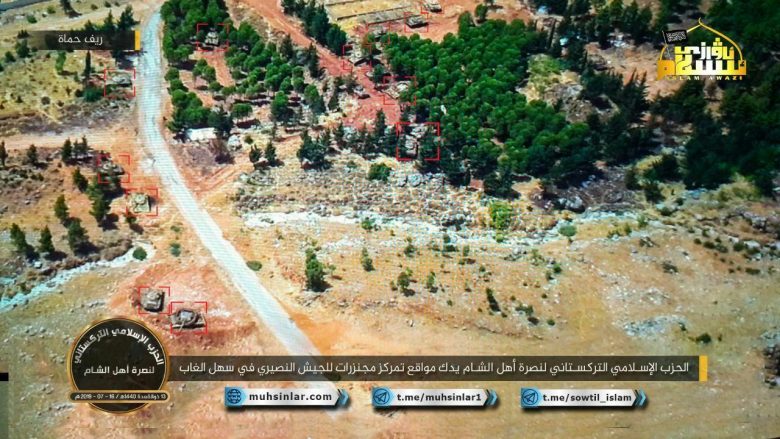
Picture (2)
On July 30, 2019, the reporter of the TIP_Official Channel published a photo captioned as attempts to repel the Syrian regular forces on the al-Kabinah Front, the Kurd Mountain.
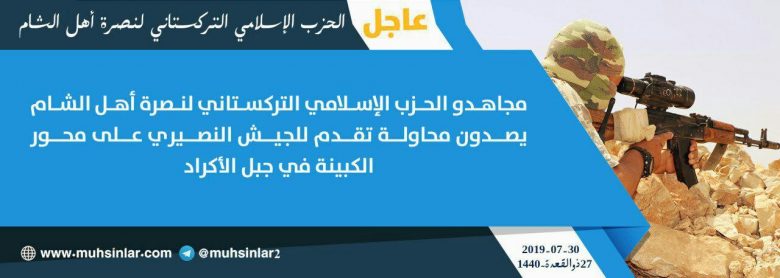
Picture (3)
On July 27, 2019, the reporter of the TIP – Official Channel, published a photo showing the participation of the Party with the Ansar al-Tawhid armed group in the Ghab Plain, rural Hama.
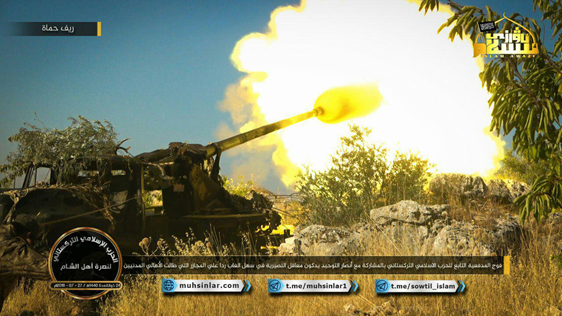
Picture (4)
On August 6, 2019, the reporter of the TIP – Official Channel, published a photo captioned as targeting the sites of the Syrian regular forces in the Jureen Military Camp and Hakoura.
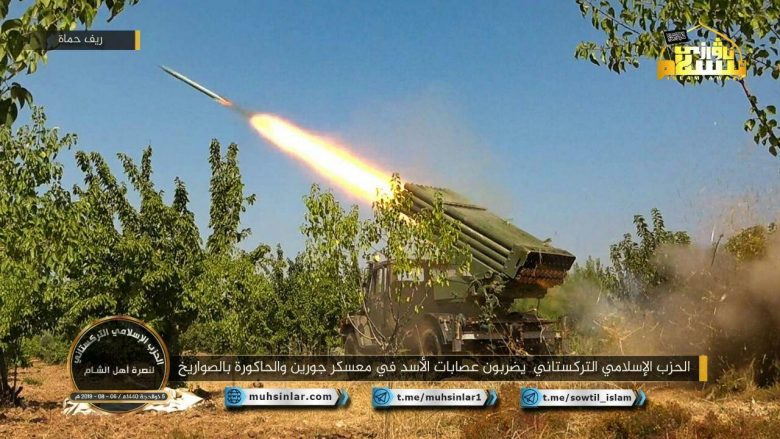
Picture (5)
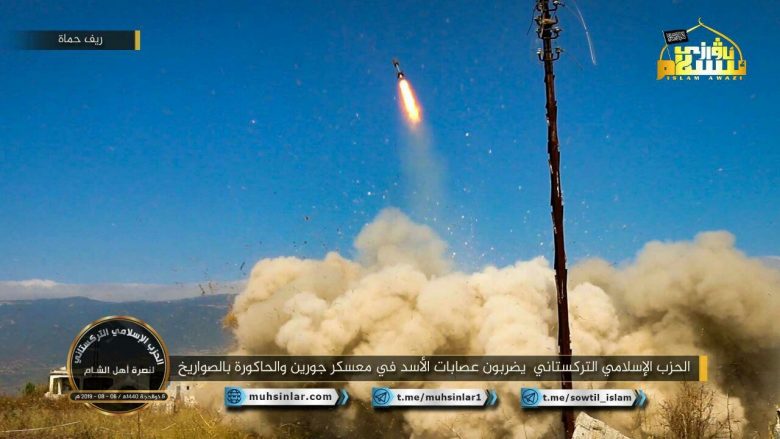
Picture (6)
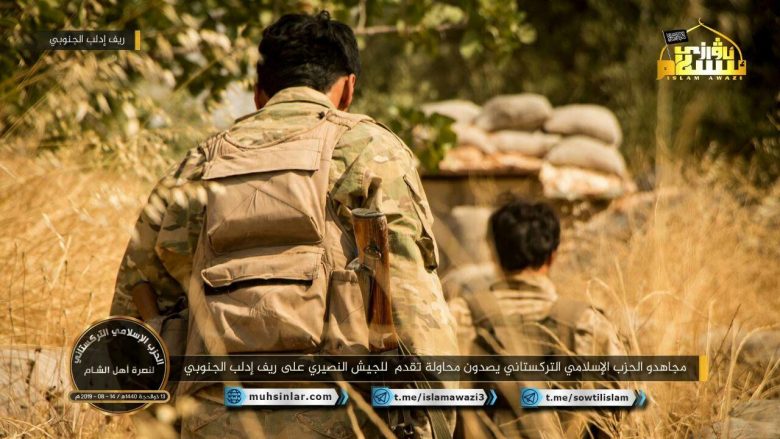
Picture (7)
On August 18, 2019, the reporter of the TIP – Official Channel, published a photo showing the Party’s participation in southern rural Idlib’s battles.
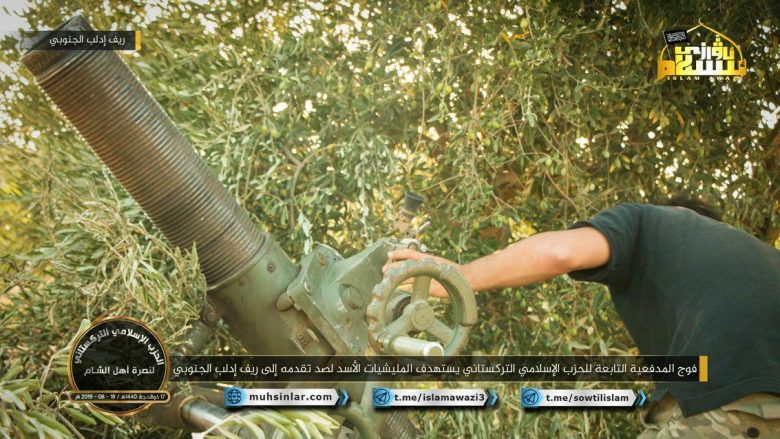
Picture (8)
2. TIP Takes Over al-Ziyara Distric in al-Ghab Plain, western Hama:
In the summer of 2015, the TIP took control of al-Ziyara District, al-Ghab Plain to the west of Hama, which encompasses the towns and villages of al-Ziyara, Qastoun, Zayzoun, al-Duqmaq, and Qlaiding, as well as Jisr al-Shughour, west of Idlib, after the Syrian regular forces withdrew from them on August 10 of the same year.
Tightening its grip over the villages and towns in these areas, the TIP announced that public facilities and infrastructure belong to the Party’s financial department and that are now at the disposal of the finance official Zaid Turkistani—the Zayzoun Power Station and the nearby transfer station in particular, added to them the grain warehouses in the vicinity of the city of Jisr al-Shughour, schools, al-Ziyara Agricultural Bank, the Drinking Water Department in al-Ghab Plain, as well as the al-Assi Basin Company and the irrigation dams in the towns of Zayzoun and Qastoun.
At the onset of 2016, the TIP began dismantling and selling the Zayzoun Power Station’s equipment either as scrap to merchants in Northern Syria or as operable devices resorting to local intermediaries. The Party, along with HTS, confiscated lands belonging to the Christian residents of al-Ziyara District and offered them in rent to local farmers for varied amounts of money.
After it seized the Zayzoun Power Station and plundered the equipment it contained, in early April 2019, the TIP proceeded to excavate for the gas pipelines, which feed the station, to remove the pipes and then sell them to local merchants.
According to STJ’s field researcher, the al-Ziyara District in western rural Hama is still outside the control of the Syrian regular forces, along with several villages and towns in the Qalaat al-Madiq area, which the Syrian regular forces controlled between 9 and May 16, 2019, following confrontations with the armed opposition groups. It is also worth mentioning that ITP-affiliated fighters are stationed in the al-Ziayra District on fronts with the Syrian regular forces, located in the town of Khirbet al-Naqus, the outskirts of the village of Hakura and on the borders of the village of al-Sarmaniya.
The TIP stated that it had worked earlier to prevent logging and looting of homes in the towns of al-Ziyara, Tal Wasit, al-Qarqur and Mashik in rural Hama, while its fighters pillaged the contents of schools and the al-Ziyara Agricultural Bank in the al-Ziyara District in the spring of 2017, pointing out that besides the Party-affiliated fighters, there are others operating within the ranks of HTS, NFL, and a few others of Hurass ed-Din/ Guardians of Religion Organization.
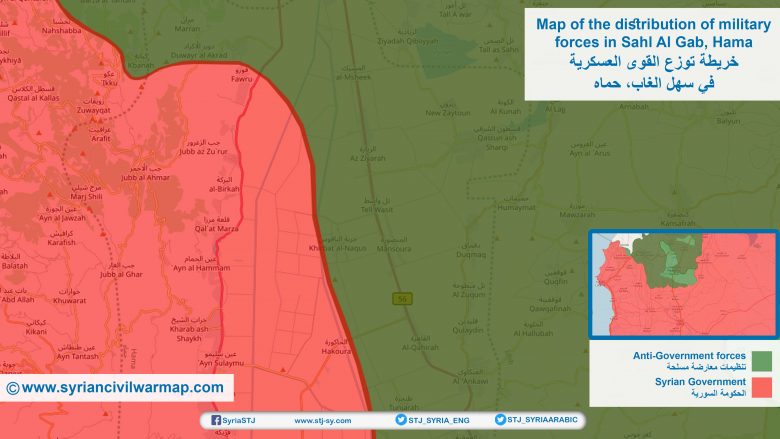
Picture (9) – A map showing the positioning of military forces within Hama Province as far as September 20, 2019. Photo credit: Syrialivemap.
3. Importance of the Gas Pipelines Feeding the Zayzoun Power Station:
The gas pipelines feeding the Zayzoun Power Station gain importance from the fact that gas is extracted from the Omar oil field in Deir ez-Zor Province, while the network channeling it passes through the al-Gibsa gas fields south of al-Hasaka, where it gets supplemented by a different type of gas. In general, the Zayzoun Power Station is operated by methane gas, according to engineer Salim al-Sattouf, a former staffer in the station, who worked there for more than 6 years. He reported to STJ that the quantities of compressed gas that Zayzoun Power Station demands amounts to 135 cubic meters per hour, under a pressure ranging from 18 to 35 bar (unit of air and gas pressure measurement).
He affirmed that the gas fed to the Zayzoun Power Station is extracted from national oil fields, supplied to various other power generation plants in Syria, including al-Taim Power Station in Deir ez-Zor Province, al-Suwaidiya in al-Hasaka and eastern Aleppo and Jandar in Homs Province, as well as the power stations of Mahrde, Zayzoun and al-Zara in Hama Province.
Commenting on the route of the gas pipelines, the witness pointed out that it starts from the Omar field and oil fields in the desert of Deir ez-Zor and al-Hasaka, from where it heads to eastern Aleppo, then to Palmyra, Homs, and Rastan, after which it reaches Mahrde and Zayzoun stations across the a-Ghab Plain, adding that the network is set up by the Syrian Lead Company, owned by the businessman Nizar al-Asa’ad.
4. Seizure and Pillage of the Gas Pipeline in al-Ziyara District, al-Ghab Plain:
As of early April 2019, the TIP has been working to dig out the pipelines that feed the Zayzoun Power Station, where the digging operations targeted first the parts near the power plant and continued towards the south.
On this note, a former employee of the Zayzoun power station recounted the following account to STJ:
“The Turkistan Islamic Party has assigned a group of people, from Jisr al-Shughur area, the task of organizing and gathering workers (blacksmiths and porters), to dig for the gas pipelines. The Party, next, divided the workers into 4 groups— two groups had to do a morning shift, while the other two had to work at night— as they were supposed to start the digging process from inside the station by bulldozers and drillers, seeking the copper pipes buried underground. Then, the blacksmiths would come to separate the pipes, attached to each other, using cutting machines, the rest of the group will remove the pipes and place them above the digging site. These pipes are then loaded onto cars. These excavations continued for more than 4 months, targeting the gas pipeline passing through the agricultural lands, located near the towns of Ziyadiye, al-Mashik, al-Ziyara, Tal Wasit and Mansoura in western rural Hama. The digging process was not completed due to the intense security conditions and the fact that the Syrian regular forces are bombarding these areas with heavy artillery.”
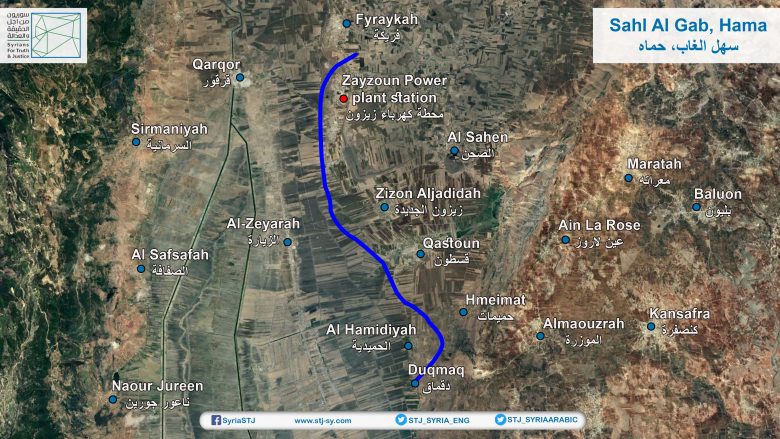
Picture (10)- Satellite image tracks the location of digging operations carried out and still being carried out by the Turkistan Islamic Party to seize pipelines feeding the Zayzoun power station after 2019.
For his part, Ahmed al-Ghabi, al-Ziyara-based activist, confirmed that the towns and villages of Qastoun, Zayzoun, Hmaimat, Shaghoureet, and al-Ziyadia in western rural Hama were subjected to bombing by the Syrian regular forces, who responded to the operations of digging and deporting the gas pipelines, which feed the Zayzoun Power Station, carried out by the TIP. He stated that the artillery launched by the Syrian regular forces stationed at al-Mashari Checkpoint in the al-Ziyadiya Town, have targeted Zayzoun town with more than 9 shells on May 22, 2019, inflecting massive destruction upon civilian homes, as nightly shelling had focused on one of the cars loaded with copper pipes while it was on its way out of the town.
On June 7, 2019, the same artillery bombarded the town of Zayzoun with about 20 mortars at night, triggered by the activities of the drilling and transport machines, deployed for digging out the pipelines leading to the power station.
On August 23, 2019, al-Ghabi added, the artillery of the Syrian regular forces, stationed in the Jurin Camp, bombarded the villages of Qastoun, Hmaimat and Shaghoureet, which resulted in the injury of two civilians, from the villages of Shaghoureet and Hmaimat, for the night shelling has back then aimed at the flow of trucks loaded with pipes, which passed through the mentioned towns.
He added that radio communication was monitored, during which the Syrian regular forces have, since the beginning of May 2019, ordered the militants managing the artillery to target the vehicles and people working to dig out the gas pipelines leading to the Zayzoun Power Station.
5. Environmental Risks of Methane Extraction:
According to geologist Mohammad alMusttafa, methane, the gas used to feed the Zayzoun Power Station, can be defined as an odorless flammable gas, which exists in the atmosphere in small quantities. The molecule consists of one carbon atom bound to four hydrogen atoms (CH4) that makes methane the simplest member of the chemicals family known as hydrocarbons, which includes ethane (C2H6), propane (C3H8) and butane (C4H10).
About the uses of the gas, he added that methane is used in the manufacture of several organic compounds such as chloroform and carbon tetrachloride deployed in extinguishing fires and as solvents, while it is incorporated in many industries such as plastic, nylon, alcohol and formaldehyde. It also constitutes about 80% of the natural gas used as fuel, as it is used in combustion to obtain energy, for a kilogram of it emits 13300 calories, equivalent to 55,594 Joules,[14] not to mention that it is used in the manufacture of nitromethane, a component of medicines, pesticides and fireworks.
Al-Musttafa added that the release of varying amounts of methane gas into the air, as a result of drilling operations aimed at the gas pipelines that feed the Zayzoun Power Station, carried out by the TIP, may cause damage to the environment, especially since methane gas has the effect of greenhouse gases, it absorbs heat and does not allow it to reradiate. He stressed that methane is 25 times more dangerous than carbon dioxide, describing it as the most fatal to the planet. He also pointed out that an increasing rate of methane in the atmosphere has a negative impact on the Ozone Layer. Although methane is classified as a nontoxic gas, it might cause deadly suffocation if a person is exposed to large quantities, for it has a high ability to displace oxygen and replace it, causing any living organism to suffocate.
6. Contents of al-Assi Basin Company Seized and Pillaged by Syrian Regular Forces and then by the TIP:
The establishment of the al-Assi Basin Company, al-Ziyara District-division, dates back to 1994, which back then was affiliated to the General Directorate of Water Resources in Hama Province and was primarily responsible for regulating and pumping irrigation water from the al-Assi River to the Qastoun and Zayoun dams.
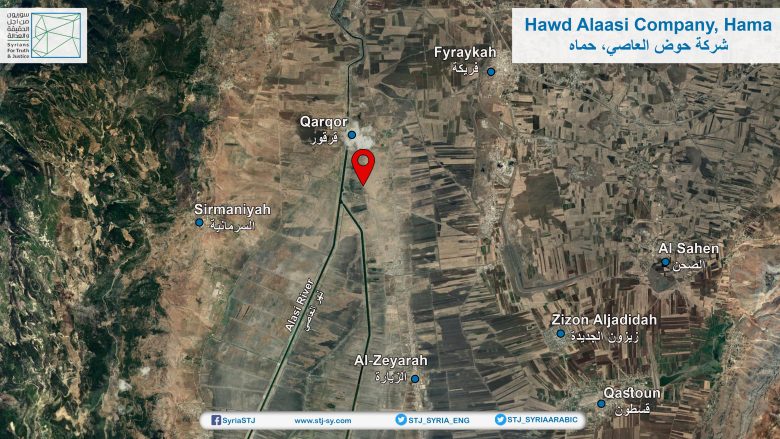
Picture (11)
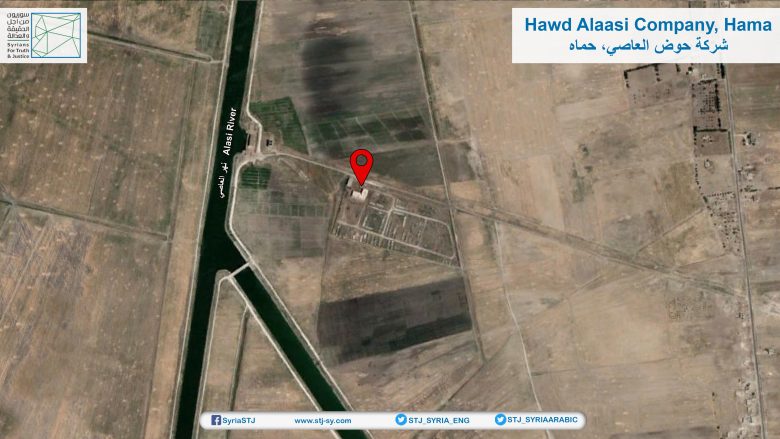
Picture (12) – Satellite image showing the location of the al-Assi Basin Company in the al-Ziyara District.
The al-Ziyara division of the al-Assi Basin Company is located near the al-Assi River, west of al-Mashik Village, where the department contained logistic equipment and devices required for pumping irrigation water towards the mentioned dams, according to Nazim al-Salloum, a former staffer of the company. He recounted the following to STJ:
“The company’s administration has 10-acre-area warehouse, which contains equipment and supplies for the maintenance of irrigation water pumping lines on the one hand, and the maintenance of pumps and engines that were responsible for drawing water from the river and pumping it towards the dams on the other hand, as well as agricultural and service vehicles—motorcycles, bulldozers, small and big, and pickup trucks. In 2011, when the Syrian regular forces were deployed in the al-Ziyarah District and took over the headquarters of the company, turning it into a military post, a number of the militants embarked on dismantling the pumps on the river’s body and selling them to local merchants, under the watch of the department’s employees who were there for the sake of attendance only, after the regular forces were stationed in the administration’s building.”
In May 2012, he added, the militias affiliated with the Syrian regular forces dismantled 3 out of 7 pumps and dissected them into parts, which they then sold as spare parts, stressing that these militias seized only the mentioned pumps but did not approach the warehouse or the equipment, logistics and vehicles it contained.
After the Syrian regular forces retreated from the aforementioned division in June 2013, the company resumed its tasks with only 4 pumps, efforts that continued until the summer of 2015, when confrontations broke out between the armed opposition groups and the Syrian regular forces that ended up with the groups’ control of the al-Ziyara District. As a consequence, the company’s division was doomed to stop again while the staffers were forced to abandon their jobs after the TIP took over all the public utilities, for in August, the Party declared the al-Ziyara District a military zone, under its administration, including facilities and public properties.
Since the onset of 2016, the TIP has turned the company’s division in the district of al-Ziyarah into a military station, for its fighters have established posts corresponding to the points of the Syrian regular forces, separated from each other by the al-Assi River only.
Having finished looting the Zayzoun Power Station, the railway, and public buildings in the al-Ziyarah District, the TIP turned to the company’s division and openly announced, through local agents, that it will auction its properties from March 2019.
Activist Ahmed al-Ghabi stated that the TIP started using the bulldozers, kept in the company’s warehouse, for its combat activities, especially for creating mounds and digging trenches. Additionally, it granted the warehouse’ motorcycles to its fighters, for they are Japanese-made and are not abundantly available in the market, given their high prices. Speaking of the cars, there were four 4-wheel Pickup cars in the warehouse that the party also used during confrontations. He added:
“In the spring of 2019, we started to see cars that sell scrap and spare parts heading to the al-Assi Basin Company, west of the village of al-Mashik, from where they emerged loaded with supplies of pumps and irrigation lines. The party also started selling pottery and iron pipes for 5000 Syrian pounds per pottery pipe, 4 meters long, and 15,000 Syrian pounds for the pipes made of steel. These pipes were kept at the division as spare parts for the pipelines channeling the pumped irrigation water. The Party entrusted the buying and selling deals to a person called Karim Khal, a fighter of the Party from East Turkistan.”
In turn, one of the area’s merchants, confirming what al-Ghabi has reported, added that the so-called Karim Khal is a member of the General Financial Department of the Party, run by a person called Zaid al-Turkistani. He also pointed out that the Party transported hundreds of pottery and steel pipes to the fronts with the Syrian regular forces, to use them as shields from mortars and missiles, after its fighters filled them with dirt.
He added that the TIP sold all the possessions of the al-Assi Basin Company in the al-Ziyara District, except for dozens of steel and pottery pipes that are still piled in the warehouse, which the Party plans to sell according to demand.
[1] STJ published a report covering confiscation and acts of pillage that aimed at the Zayzoun Power Station, as well as plundering and then selling the equipment within it by the Turkistan Islamic Party in early 2019. “Syria: Over 100 Houses and Shops Seized by HTS in Rural Hama.” STJ, September 9, 2019. Last visited: March 30, 2020. https://stj-sy.org/en/1256/.
[2] “Seizure of Public and Private Properties in Jisr al-Shughur- Idlib Countryside.” STJ, September 25, 2017. Last visited March 30, 2020. https://stj-sy.org/en/261/.
[3] Several sources also indicated that the TIP maintains close ties with the East Turkestan Islamic Movement/ETIM—a jihadi organization founded in 1993 by both Hassan Mahsum and Abdulqadir Yabuquan. In 1998, Hassan Mahsum moved the ETIM’s headquarters to Kabul, seeking shelter in the shadow of the Taliban in Afghanistan, where the movement’s leaders met Osama bin Laden and other heads of Qaeda, as well as of Taliban and the Islamic Movement of Uzbekistan, attempting to come up with a mechanism for joint coordination between them.
[4] “Strategic Anchor of the Turkistan Islamic Party in Syria.” Syria TV, June 23, 2019. Last visited: March 30, 2020. https://www.syria.tv/%D8%A7%D9%84%D9%85%D8%B1%D8%AA%D9%83%D8%B2%D8%A7%D8%AA-%D8%A7%D9%84%D8%A7%D8%B3%D8%AA%D8%B1%D8%A7%D8%AA%D9%8A%D8%AC%D9%8A%D8%A9-%D9%84%D9%84%D8%AD%D8%B2%D8%A8-%D8%A7%D9%84%D8%A5%D8%B3%D9%84%D8%A7%D9%85%D9%8A-%D8%A7%D9%84%D8%AA%D8%B1%D9%83%D8%B3%D8%AA%D8%A7%D9%86%D9%8A-%D9%81%D9%8A-%D8%B3%D9%88%D8%B1%D9%8A%D8%A7.
[5] Hage Ali, Mohammad. “A Different Type of Jihadi.” Carnegie Middle East Center, August 13, 2019. Last visited: March 30, 2020. https://carnegie-mec.org/diwan/72935.
[6] “Seizure of Public and Private Properties in Jisr al-Shughur- Idlib Countryside.” STJ, September 25, 2017. Last visited: March 30, 2020. https://stj-sy.org/en/261/.
[7] Hage Ali, Mohammad. “A Different Type of Jihadi.” Carnegie Middle East Center, August 13, 2019. Last visited: March 30, 2020. https://carnegie-mec.org/diwan/72935.
[8] Hassan, Aqil. “The Turkistan Islamic Party: The Levant Phase.” Almodon, June 29, 2016. Last visited: March 30, 2020. https://www.almodon.com/arabworld/2016/6/29/%D8%A7%D9%84%D8%AD%D8%B2%D8%A8-%D8%A7%D9%84%D8%A5%D8%B3%D9%84%D8%A7%D9%85%D9%8A-%D8%A7%D9%84%D8%AA%D8%B1%D9%83%D8%B3%D8%AA%D8%A7%D9%86%D9%8A-%D8%A7%D9%84%D9%85%D8%AD%D8%B7%D8%A9-%D8%A7%D9%84%D8%B4%D8%A7%D9%85%D9%8A%D8%A9.
[9] For further information, refer to the following link: https://www.webcitation.org/query?url=http%3A%2F%2Fwww.treas.gov%2Fpress%2Freleases%2Ftg92.htm&date=2009-09-29.
[10] “Islamic Turkistan Party: Special Qaeda Experience on Syrian Stage.” Asbar- Policy Analysis Unit, April 10, 2019. Last visited: March 30, 2020. http://aletihadpress.com/2019/04/10/%D8%A7%D9%84%D8%AD%D8%B2%D8%A8-%D8%A7%D9%84%D8%A5%D8%B3%D9%84%D8%A7%D9%85%D9%8A-%D8%A7%D9%84%D8%AA%D8%B1%D9%83%D8%B3%D8%AA%D8%A7%D9%86%D9%8A-%D8%AA%D8%AC%D8%B1%D8%A8%D8%A9-%D9%82%D8%A7%D8%B9%D8%AF/.
[11] The previous reference.
[12] The previous reference.
[13] Ahmad, Adnan. “Qaeda and Sister Organizations in Idlib: Turkistan Islamic Party’s Retaliation against China (4).” The New Arab, October 15, 2018. Last visited: March 30, 2020. https://www.alaraby.co.uk/politics/2018/10/14/%D8%AA%D9%86%D8%B8%D9%8A%D9%85%D8%A7%D8%AA-%D8%A7%D9%84%D9%82%D8%A7%D8%B9%D8%AF%D8%A9-%D9%88%D8%A3%D8%AE%D9%88%D8%A7%D8%AA%D9%87%D8%A7-%D9%81%D9%8A-%D8%A5%D8%AF%D9%84%D8%A8-%D8%A7%D9%84%D8%AA%D8%B1%D9%83%D8%B3%D8%AA%D8%A7%D9%86%D9%8A-%D9%84%D9%84%D8%A7%D9%86%D8%AA%D9%82%D8%A7%D9%85-%D9%85%D9%86-%D8%A7%D9%84%D8%B5%D9%8A%D9%86-4.
[14] Joule is used to measure all forms of energy, including heat, electric and mechanical energy. One joule equals about 0.24 calories. A calorie, however, is the amount of heat required to raise the temperature of one gram of water a single Celsius degree.

